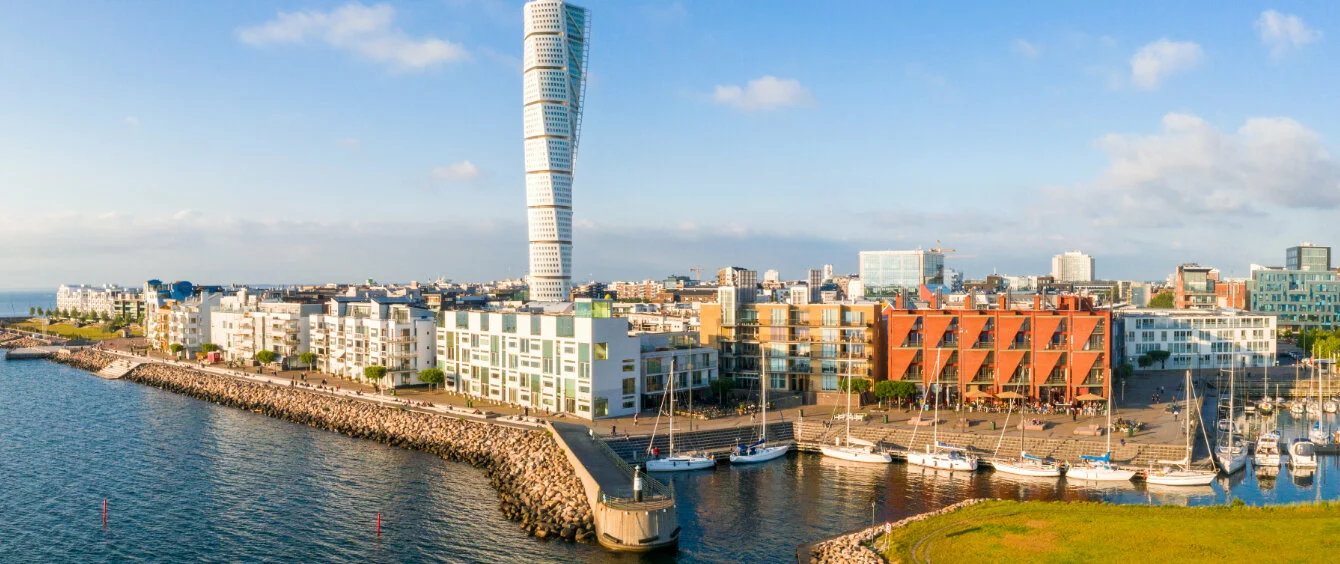Sweden is considered something of a model student when it comes to the energy transition. Its share of electricity consumption accounted for by renewable energy clocked in at almost 55 percent in 2020. The EU-wide average, on the other hand, was most recently still lurking below 20 percent. But it doesn’t stop there. The Scandinavian country is aiming to turn carbon neutral by 2045 – five years ahead of the European Union. The city of Malmö in southern Sweden has its sights set on even more ambitious targets. The entire metropolis is to become carbon neutral by 2030. Innovative solutions, which not only replace fossil fuels with renewable energy sources, but which use energy more efficiently in general, are needed to make this happen. The same goes for the heating supply of the city’s 300,000 inhabitants. In this particular case, thermal energy from both a sewage treatment facility and a waste incineration plant will be used in a pilot project, where it will be enhanced by 100 percent renewably powered heat pumps before being fed into the district heating network.
The concept itself is anything but new. For decades now, waste heat, generated as a by-product of industrial processes in power stations, has been used to heat water. It is then pumped through pipes into residential buildings, where it is used for heating or as hot water, for example. Cogeneration in coal or gas-fired power plants is most common in this regard. These stations go further than simply generating power. They also harness the heat released during combustion. This is energy efficient and reduces greenhouse gas emissions, which would otherwise be emitted by oil and gas-fired central heating. Now, many countries are opting to expand their networks, particularly in light of impending climate goals. However, as district heating still often stems from fossil fuels, generating it still emits carbon.
Heat pumps harness waste heat from wastewater
The project in Malmö, on the other hand, largely relies on renewable energy for district heating. Failing that, it uses the necessary energy particularly efficiently. First, the energy company involved uses recycled wastewater from a sewage treatment facility located in the city’s harbour. At 14 degrees Celsius, this water is still relatively warm – notably more toasty than the ground or seawater in the coastal city – but still too cold to be used for heating. The company then uses the waste heat from the city’s waste incineration plant to heat things up. Burning organic waste components is considered carbon neutral. This is because, purely mathematically speaking, the process only releases the same amount of greenhouse gases into the atmosphere as were previously removed by the vegetation.
Four heat pumps from tech company GEA with a capacity of ten megawatts (MW) apiece are next in line and are powered exclusively with renewable energy. They rely on a closed loop system, where the warmth heats a refrigerant via a heat exchanger. The refrigerant then passes the heat on, via another heat exchanger, to water, which acts as the heating medium. Many heat pumps use so-called fluorinated gases as refrigerants. They, however, increase the greenhouse gas effect. To avoid this, the project relies on natural refrigerants such as hydrocarbons or ammonia. This makes Sweden something of a pioneer, according to GEA. The system is designed for temperatures of up to 80 degrees Celsius. According to GEA, even in the depths of winter, Sweden sees little demand for hot water above 71 degrees.
In all, the 40 MW pilot plant is able to supply 10,000 households. Kenneth Hoffman, Product Manager Heat Pumps at GEA, explains: “The heat pumps work in parallel to deliver the promised temperatures. Each has a coefficient of performance (COP) above 3.5, so for each 1 kWh of electricity used by the heat pump, 3.5 kWh of heat is produced for the city.” Heat pumps with a COP of three or more are considered efficient. But the pilot plant in Malmö isn’t only economical. Combining the different technologies and relying on green energy saves approx. 50,000 metric tonnes of carbon dioxide annually.
Sustainable district heating using biomass
This project is not the only example of how district heating could be made more environmentally friendly. Other approaches also opt for biomass as their energy source.
Energy company RWE has taken this approach, e.g. in Scotland. The Group own and operate a state-of-the-art 55 MW biomass-fired combined heat and power plant near the capital city of Edinburgh. The fuel used at the plant is approximately 90% recovered wood waste and the remainder is virgin wood sourced from sustainably managed forests. Wood is considered carbon neutral because combustion only releases as much carbon dioxide as the trees capture in the first place. RWE in partnership with the Scottish Government and Fife Council have developed Glenrothes Energy Network, which officially opened in March 2019. RWE’s Markinch Biomass CHP Power Station supplies 100% renewable heat to the district heating scheme – Glenrothes Energy Network through a constructed Energy Centre.
Glenrothes Energy Network
RWE is also pursuing a similar concept at the Amer power station in Geertruidenberg, the Netherlands. The site currently still houses a hybrid power plant, which is run on 80 percent wood pellets made using several sustainable residual wood sources. Twenty percent of power and heat generation is coal-fired. By 2025, it is to be completely converted to run on renewable fuel. Overall, the complex of power plants has a capacity of max. 600 MW power and 350 MW heat.
The EU is also looking into sustainable heating and cooling strategies. The EU’s Horizon 2020 framework programme for research and innovation, for example, also includes the project titled ‘Renewable Energy Sources in District Heating and Cooling’. (RES-DHC). Research institutes and representatives from cities, municipalities and regions of eight countries have joined forces within the funding scheme to focus on increasing the share of renewable energy in district heating and cooling systems.
